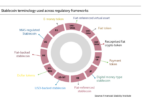Today the USDF Consortium formally launched to offer a bank-backed stablecoin that is interoperable between a network of FDIC-insured banks. Every dollar of the blockchain-based USDF is redeemable one for one by any of the consortium banks. And transfers can only be made to wallets that have been through KYC by one of the banks.
The five founding community bank members are New York Community Bank (NYCB), NBH Bank, FirstBank, Sterling National Bank, and Synovus Bank. Figure Technologies, which founded the Provenance Blockchain, and community bank group JAM FINTOP are also consortium founders promoting the adoption of the stablecoin that uses Provenance.
The key advantages of the solution are enabling low-cost, real-time interbank payments, which can also use the programmability of blockchain.
To participate in the consortium, member banks have to be FDIC insured, have at least $1 billion in assets, possess a satisfactory credit rating, and have staff to deal with Bank Secrecy Act and AML compliance. Depending on a bank’s assets, membership costs between $20,000 and $50,000.
“As a form of digital currency created and administered by regulated U.S. banks within the USDF Consortium, USDF will enable wide use of an on-chain, real time payments system that satisfies important principles of safety and soundness, compliance with anti-money laundering standards, and financial stability,” said Andrew Kaplan, NYCB’s Chief Digital and Banking as a Service Officer.
USDF was first mentioned in September 2021, but at that point, the banks pointedly avoided the use of the term stablecoin. Since then, the President’s Working Group published a report on stablecoins calling for regulated solutions.
However, it seems there is still a bit of a gray area in terms of regulation. The consortium says it has a proactive regulatory strategy and has met with the Fed, OCC and FDIC. It says it will be responsive to new regulatory guidance.
We had a few questions about how the interoperable stablecoin might work. For example, the wording used is that the stablecoin is “redeemable 1:1” versus the usual terminology “backed 1:1”. Generally, banks simply have liabilities to all account holders. So it’s likely that the stablecoin account will be the same as any other account. There’s an argument that the Paxos dollar, backed by a combination of bank balances and U.S. Treasuries, might be more ‘secure’ than the USDF.
Even if the banks are FDIC insured, will that insurance cover more than $250,000 per participant bank? JAM FINTOP clarified to Ledger Insights that the design is to have up to $250,000 coverage per depositor not per bank. If that were not the case then the network would be as robust as the weakest link.
Meanwhile, late last year TassatPay raised $40 million to roll out its Digital Interbank Network. TassatPay also avoided the stablecoin label with its intrabank payment solution currently deployed by Signature Bank, Customers Bank and Western Alliance Bank. The aim is to make them interoperable for interbank settlement.
Update: A response from JAM FINTOP clarified that the aim is to have FDIC insurance coverage per depositor not per bank.







